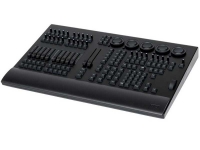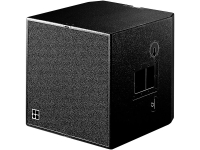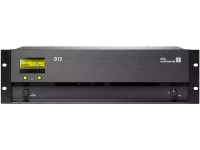ABOUT THE PRODUCT
ABOUT THE MANUFACTURER
GLOSSARY
SSL Live. L500 Plus
Large scale production powerhouse
In just a few years SSL Live consoles has met widespread praise from many of the world?s leading live engineers. SSL Live consoles are designed to help highly skilled operators deliver outstanding performances in the most demanding applications in Touring, Installation, Houses Of Worship and Theatre. Like all SSL consoles the secret to the success of the L500 Plus is SSL's dedication to great sound. Part of the success is attributable to exemplary hardware performance throughout the signal chain: bringing SSL Studio grade mic pre's to the stage, outstanding audio conversion, 96kHz operation and magnificent summing. There is a sublime transparency, definition and detail in the fundamental sound of the L500 Plus that is difficult to describe but is immediately recognisable as the SSL signature. An equal, perhaps even greater part of the secret of the power of the L500 Plus is however the way it enables operators to perform at their very best. The deceptively simple ergonomic excellence of the combination of multi-touch screen control with assignable hardware controls, the use of colour coding, the open architecture which lets engineers configure the console layout to suit their own way of working, the arsenal of processing options, the precision and depth of those processing tools? and so much more? it all combines to let the operator get where they can hear they want to be extremely quickly. Like all great creative audio technology, SSL Live consoles are instruments for engineers...
Control
Take Control
The key to a great control surface is a clear view of everything in your audio environment and finding exactly the control you need at your fingertips when you need it. With the Live SSL's obsession with ergonomics and workflow has delivered an intelligent, elegant and comfortable layout. All of the most commonly used functions are carefully arranged so that they sit within reach where your hands naturally fall on the console. There is a wealth of visual feedback with carefully considered use of colour change technology that will not fatigue the user during long periods of operation. The Live control surface delivers a genuinely intuitive combination of gestural touch screen & hardware control and a whole collection of innovative features designed to streamline workflow.
Power
The Power to Connect
The power within SSL Live consoles is provided by our new 'Tempest' platform, developed specifically to meet the demands of live production. We are of course very proud of our clever new processing technology, but at SSL our focus is always on what really matters and that is you having the power to do your job well. Live harnesses Tempest's power in a sensibly flexible way to let you balance allocation of resource between signal processing and console architecture to suit each project. Thanks to the intrinsic flexibility of our approach, no matter how you configure it, when you compare the numbers, Live gives you more Inputs and Outputs, more Channels, Stem Groups, Auxes, VCA's and Masters, more processing tools and more signal processing power than many consoles with much
Tempest
Such stuff as dreams are made on
Live consoles are powered by Tempest, a new fourth generation digital audio platform developed specifically to meet the demanding requirements of the live environment. Learning from more than 25 years of digital console development, Tempest is a ground up development. All legacy code "the key to the sonic excellence of previous generations of SSL digital consoles" has been rewritten in the latest software languages. The high capacity signal processing engine at the heart of Tempest uses SSL's patented Optimal Core Processing (OCP) to deliver highly efficient and reliable performance with minimal latency. Tempest delivers all of the power required to equip Live with all of the mixer architecture, processing power and connectivity to handle large scale events. The Live signal processing engine is integrated entirely within the control surface.
Professional used lighting equipment.| Professional second hand lighting equipment.| Professional pre owned lighting equipment.
Professional used audio equipment.| Professional second hand audio equipment.| Professional pre owned audio equipment.
Second hand audio gear. | Second hand lighting.
Pro audio equipment, second hand amplifiers, DJ, second hand sound systems, second hand Microphones, second hand Media Players.
Outdoor & Indoor LED screens for sale, LED mobile truck.
Light trussing, Gebrauchte Veranstaltungstechnik, used stage equipment Stage & Theatre lighting products.
Used SSL-Solid State Logic
Solid State Logic (SSL) is a manufacturer of high-end mixing consoles and recording studio hardware which is headquartered in Begbroke, Oxfordshire, England.
From groundbreaking audio consoles to innovative video production systems, Solid State Logic has evolved to become the world’s leading manufacturer of analogue and digital audio consoles and provider of creative tools for film, audio, video and broadcast professionals.
With more than 3000 SSL-equipped studios and facilities operational today, the excellence of SSL consoles is universally recognised for unrivalled sonic quality, superb ergonomics, outstanding automation and an international support infrastructure second to none.
Founded by Colin Sanders in 1969, SSL has since expanded to its present 15 acre science park in Oxfordshire, England. SSL's unrivalled resources, including R&D, manufacturing, training, service and product support, operate in a unique high technology, customer oriented environment.
The company invents, designs and manufactures technology for the creative manipulation of sound. Users and industry experts from all over the world visit SSL's Oxford HQ to consult with SSL audio experts and evaluate SSL equipment. There are more than 3000 SSL systems in service around the world.
Internationally famous musicians, producers and engineers working at the highest level of every musical genre choose SSL equipment to extend their creativity and ensure the highest possible quality of their finished product.
SSL technology is found in the most prestigious recording studios around the world has been used for countless hit recordings.
Independent post production companies working for multinational advertising agencies use SSL equipment to produce global advertising campaigns for the world's leading commercial brands.
Long-form video and major TV productions benefit from the unique qualities of SSL products the world over. Leading national and international broadcasters have similarly embraced the company's innovative technology to streamline operations and ensure high quality output.
The client list reads like a who's who in Radio and Television. It includes BBC UK, NHK Japan, ABC USA, Fox USA, NBC USA, CBS USA, NDR Germany, Swedish Television, RAI Italy and NOB Netherlands.
Professional used lighting equipment.| Professional second hand lighting equipment.| Professional pre owned lighting equipment.
Professional used audio equipment.| Professional second hand audio equipment.| Professional pre owned audio equipment.
Second hand audio gear. | Second hand lighting.
Pro audio equipment, second hand amplifiers, DJ, second hand sound systems, second hand Microphones, second hand Media Players.
Outdoor & Indoor LED screens for sale, LED mobile truck.
Light trussing, Gebrauchte Veranstaltungstechnik, used stage equipment Stage & Theatre lighting products.
Active: Powered. An active crossover is electrically powered and divides the line-level signal prior to amplification. An active speaker includes an active crossover and built-in amplifier.
Actuality: Audio from an announcer speaking.
Amplifier: A component that increases the gain or level of an audio signal.
Balanced Input: A connection with three conductors: two identical signal conductors that are 180 degrees out of phase with each other, and one ground. This type of connection is very resistant to line noise.
Bandpass: A two-part filter that cuts both higher and lower frequencies around a center band. A bandpass enclosure cuts high frequencies by acoustic cancellation and low frequencies by natural physical limitations on bass response.
Bandwidth: In audio, the range of frequencies a device operates within. In video, the range of frequencies passed from the input to the output. Bandwidth can also refer to the transmission capacity of an electronic communications device or system the speed of data transfer,is very important when planning a meeting for the attendees to stay connected.
Bass: Low frequencies; those below approximately 200 Hz.
Bi-Wiring: A method of connecting an amplifier or receiver to a speaker in which separate wires are run between the amp and the woofer and the amp and the tweeter.
Boost: To increase, make louder or brighter; opposite of attenuate.
Bridging: Combining two channels of an amplifier to make one channel that more powerful. One channel amplifies the positive portion of an audio signal and the other channel amplifies the negative portion, which are then combined at the output.
CD: Compact Disc. Ubiquitous digital audio format. Uses 16-bit/44.1-kHz sampling rate PCM digital signal to encode roughly 74 or 80 minutes of two- channel, full-range audio onto a 5-inch disc.
CD-R: Recordable Compact Disc.
CD-RW: Rewritable Compact Disc.
Channel: In components and systems, a channel is a separate signal path. A four-channel amplifier has at least four separate inputs and four separate outputs.
Coloration: Any change in the character of sound (such as an overemphasis on certain tones) that reduces naturalness.
Crossover: A component that divides an audio signal into two or more ranges by frequency, sending, for example, low frequencies to one output and high frequencies to another. An active crossover is powered and divides the line-level audio signal prior to amplification. A passive crossover uses no external power supply and may be used either at line level or, more commonly, at speaker level to divide the signal after amplification and send the low frequencies to the woofer and the high frequencies to the tweeter.
Crossover Frequency: The frequency at which an audio signal is divided. 80 Hz is a typical subwoofer crossover point and is the recommended crossover point in theatrical and home THX systems. Frequencies below 80 Hz are sent to the subwoofer signals above 80 Hz are sent to the main speakers.
Cut: To reduce, lower; opposite of boost.
Decibel (dB): A logarithmic measurement unit that describes a sound`s relative loudness, though it can also be used to describe the relative difference between two power levels. A decibel is one tenth of a Bel. In sound, decibels generally measure a scale from 0 (the threshold of hearing) to 120-140 dB (the threshold of pain). A 3dB difference equates to a doubling of power. A 10dB difference is required to double the subjective volume. A 1dB difference over a broad frequency range is noticeable to most people, while a 0.2dB difference can affect the subjective impression of a sound.
Delay: The time difference between a sonic event and its perception at the listening position (sound traveling through space is delayed according to the distance it travels). People perceive spaciousness by the delay between the arrival of direct and reflected sound (larger spaces cause longer delays.
Diaphragm: The part of a dynamic loudspeaker attached to the voice coil that produces sound. It usually has the shape of a cone or dome.
Diffusion: In audio, the scattering of sound waves, reducing the sense of localization. In video, the scattering of light waves, reducing hot spotting, as in a diffusion screen.
Digital Audio Server: Essentially a hard drive, a digital audio server stores compressed audio files (like MP3 or WMA). Most include the processing to make the files, and all have the ability to play them back.
Direct-Stream Digital: A format for encoding high-resolution audio signals. It uses a 1-bit encoder with a sampling rate of 2,822,400 samples per second (verses 44,100 for CD). Used to encode six high-resolution channels on SACD.
Dispersion: The spread of sound over a wide area.
Distortion: Any undesired change in an audio signal between input and the output.
DNR: Dynamic Noise Reduction. A signal-processing circuit that attempts to reduce the level of high-frequency noise. Unlike Dolby NR, DNR doesn’t require preprocessing during recording.
Dolby B: A noise-reduction system that increases the level of high frequencies during recording and decreases them during playback.
Dolby C: An improvement on Dolby B that provides about twice as much noise reduction.
Dolby Digital: An encoding system that digitally compresses up to 5.1 discrete channels of audio (left front, center, right front, left surround, right surround, and LFE) into a single bitstream, which can be recorded onto a DVD, HDTV broadcast, or other form of digital media. When RF-modulated, it was included on some laser discs, which requires an RF-demodulator before the signal can be decoded. Five channels are full-range; the .1 channel is a band-limited LFE track. A Dolby Digital processor (found in most new receivers, preamps, and some DVD players) can decode this signal back into the 5.1 separate channels. Most films since 1992`s Batman Returns have been recorded in a 5.1 digital format, though a number of films before that had 6-channel analog tracks that have been remastered into 5.1.
Dolby EX: An enhancement to Dolby Digital that adds a surround back channel to 5.1 soundtracks. The sixth channel is matrixed from the left and right surround channels. Often referred to as 6.1. Sometimes referred to as 7.1 if the system uses two surround back speakers, even though both speakers reproduce the same signal. Software is backwards-compatible with 5.1 systems, but requires an EX or 6.1 processor to obtain additional benefit.
Dolby Pro Logic: An enhancement of the Dolby Surround decoding process. Pro Logic decoders derive left, center, right, and a mono surround channel from two-channel Dolby Surround encoded material via matrix techniques.
Dolby Pro Logic II: An enhanced version of Pro Logic. Adds improved decoding for two-channel, non-encoded soundtracks and music.
Driver: A speaker without an enclosure; also refers to the active element of a speaker system that creates compressions and rarefactions in the air.
DSP: Digital Signal Processing. Manipulating an audio signal digitally to create various possible effects at the output. Often refers to artificially generated surround effects derived from and applied to two-channel sources.
DTS: Digital Theater Systems. A digital sound recording format, originally developed for theatrical film soundtracks, starting with Jurassic Park. Records 5.1 discrete channels of audio onto a handful of laser discs, CDs, and DVDs. Requires a player with DTS output connected to a DTS processor.
DTS ES: An enhanced version of the 5.1 DTS system. Like Dolby’s Surround EX, a sixth channel is added. In some cases (DTS ES Discrete), the sixth channel is discrete. Software is backwards-compatible with 5.1 systems, but requires an ES or 6.1 processor to obtain additional benefit. Neo: 6 is a subset of DTS ES that creates 6.1 from material with fewer original channels.
Dynamic Range: The difference between the lowest and the highest levels; in audio, it’s often expressed in decibels. In video, it’s listed as the contrast ratio.
Professional used lighting equipment.| Professional second hand lighting equipment.| Professional pre owned lighting equipment.
Professional used audio equipment.| Professional second hand audio equipment.| Professional pre owned audio equipment.
Second hand audio gear. | Second hand lighting.
Pro audio equipment, second hand amplifiers, DJ, second hand sound systems, second hand Microphones, second hand Media Players.
Outdoor & Indoor LED screens for sale, LED mobile truck.
Light trussing, Gebrauchte Veranstaltungstechnik, used stage equipment Stage & Theatre lighting products.































